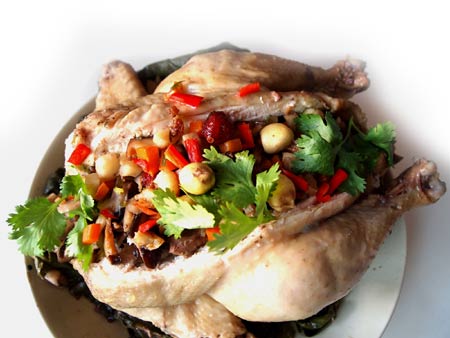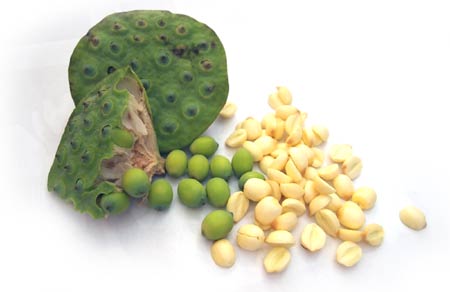Lotus eaters
Updated: 2012-08-12 07:54
By Pauline D. Loh (China Daily)
|
||||||||
|
 Tender chicken stuffed with lotus seeds and mushrooms wrapped in lotus leaves, and steamed. [Pauline D Loh / China Daily] |
Lotus roots, pods and seeds are far from the soporifics described in Greek mythology, but in the hazy, lazy days of summer, eating lotus can be good for you. Pauline D. Loh shows you how.
The Chinese lotus is a flower that rises from the mud, pure and untainted. For this unique quality, it is honored as the floral icon of summer, just as the orchid is spring's herald and autumn has chrysanthemums and winter, the plum blossoms.
But it is also a plant valued for its medicinal properties from roots to seeds and almost everything in between.
Lotus roots are eaten mainly in summer, enjoyed in a cornucopia of dishes ranging from appetizers to soups.
It is boiled with pork ribs for a nourishing, heat-clearing tonic; it is sliced and pickled for a crisp, clean, crunchy appetizer; it is stuffed with sticky rice and slow-cooked in syrup scented by osmanthus flowers for a delicious dessert; and it is sliced thin and stuffed with minced pork for lotus "boxes".
In traditional Chinese pharmacology, the lotus root clears phlegm, cleanses the body of heat toxins and promotes better circulation. It is also believed to stem any internal hemorrhage.
Lotus leaves are used as wraps for a variety of dishes, the most famous being Beggar's Chicken, the aromatic bird that is baked in mud and cracked open at the dinner table.
Cantonese cooks and chefs from the Huaiyang region also use lotus leaves to wrap up delicate parcels of delicious morsels, including glutinous rice and chicken that is steamed within the leaves.
In Beijing, my sisters-in-law boil the lotus leaves in water and drink it, because they swear that's the best summer cooler.
Fresh lotus pods are now in season, and in the historic town of Jingzhou, a strategic battle point during the Three Kingdoms period, modern farmers are selling lotus pods on Taobao.com. The pods cradle fresh lotus seeds, which are fresh, tender and sweet and edible on their own as a refreshing, if fiddly snack.
It's a bit fussy to eat, because you have to tear open the pods, then slowly remove the tough skin and thin protective filament around the seeds. And before you crunch into the tender seeds, you have to squeeze them open and eject the immensely bitter shoot hiding in there.
These tiny shoots are treasured as blood cleansers, and when we were teenaged girls, my grandmother used to make us drink their bitter infusion. That always cleared up the pimples overnight.
When the lotus seeds are dried, they become an indispensable pantry basic for soups or vegetarian dishes. And when it's time to make dumplings during the Dragon Boat Festival or moon cakes during Mid-Autumn, these seeds are made into a sweet paste for fillings.
The lotus is also revered as a religious symbol in both China and India.
The Chinese Goddess of Mercy, Guanyin, is most often depicted standing or sitting on an open lotus flower, and many Indian deities hold stalks of lotus in their hands - while their pedestals, more often than not, are blue lotus flowers.
That probably inspired the famous Tintin comics named after the flower.
The lotus is a plant that looks good and tastes good, and it deserves its place in Chinese history, literature, art and culinary heritage as an indispensable inspiration.
And yet throughout it all, it has remained accessible, and might I add, delicious.
Contact the writer at paulined@chinadaily.com.cn.
|
 |
Recipe: Lotus-wrapped steamed chicken
Ingredients (serves 4 to 6):
1 young chicken, about 1.5kg
Half cup rice, rinsed and drained
1 Chinese sausage, thinly sliced
Half a carrot, peeled and diced
1 cup dried lotus seeds, soaked beforehand
2-3 dried Chinese mushrooms, soaked and diced
1 stalk spring onions, chopped
2-3 water chestnuts, skinned and diced
1 tbsp oyster sauce
I cup chicken stock or water
Rub for chicken:
1 tsp salt
1 tsp pepper
1 tsp five-spice powder
2-3 large lotus leaves, either fresh or dried
(soak the dried leaves before use)
Method:
1. Clean the chicken and dry it well with paper towels. Briskly rub the chicken with salt, pepper and five-spice powder, including the cavity. Leave aside to marinate.
2. Heat up some oil in a frying pan, and saut the Chinese sausage slices. Add diced mushrooms, carrots, water chestnuts and lotus seeds.
3. Add rice and stir through to mix the ingredients. Season with oyster sauce and mix well. Add the cup of water and turn down the heat to cook until rice is tender. Leave the rice mixture to cool.
4. Spoon the cooled rice mixture into the chicken cavity and skewer the opening shut.
5. Place the lotus leaves flat on a board and lightly oil them, Place the chicken on top and fold the leaves over. Tie with string to secure.
6. Steam the chicken for 90 minutes. Allow to rest for a few minutes before you plate and cut open the leaves. (It's easier to use kitchen scissors.)
Recipe: Lotus root & pork ribs soup
Ingredients (serves 4):
500g lotus roots
300g pork ribs, cut into bite-sized pieces
2-3 dried Chinese red dates (jujubes)
1 tbsp wolfberries (goji berries)
Salt to taste
Method:
1. Scrub lotus root clean and chop off the tail ends. For a cleaner-looking soup, skin the root with a vegetable peeler. Cut the root into thin slices.
2. Blanch the pork ribs in boiling water for three minutes, drain and rinse clean.
3. Heat up another pot of water (about 1.5 liters) and add all the ingredients.
4. Bring to a rapid boil for about 5 min, then turn heat low to a gentle simmer. Leave to cook for about 90 minutes or until lotus roots are tender.
5. Season the soup to taste. Serve the soup, and plate the lotus root slices and pork ribs on a separate plate with some soy sauce for dipping.
Recipe: Lotus seeds sweet soup
Ingredients (serves 4):
100g dried lotus seeds (soaked overnight)
4-5 fresh water chestnuts, peeled
50g wolfberries
Rock sugar to taste
Method:
1, Place water chestnuts on a cutting board and smash them lightly.
2. Fill up a pan with water and add lotus seeds and water chestnuts. Bring to a boil and then turn down to a simmer. Cook until lotus seeds begin to break up, about an hour or less.
3. Add rock sugar to taste, and the wolfberries just before serving.
4. Chill leftovers for a cool, sweet treat.

 'Taken 2' grabs movie box office crown
'Taken 2' grabs movie box office crown
 Rihanna's 'Diamonds' tops UK pop chart
Rihanna's 'Diamonds' tops UK pop chart
 Fans get look at vintage Rolling Stones
Fans get look at vintage Rolling Stones
 Celebrities attend Power of Women event
Celebrities attend Power of Women event
 Ang Lee breaks 'every rule' to make unlikely new Life of Pi film
Ang Lee breaks 'every rule' to make unlikely new Life of Pi film
 Rihanna almost thrown out of nightclub
Rihanna almost thrown out of nightclub
 'Dark Knight' wins weekend box office
'Dark Knight' wins weekend box office
 'Total Recall' stars gather in Beverly Hills
'Total Recall' stars gather in Beverly Hills
Most Viewed
Editor's Picks

|

|

|

|

|

|
Today's Top News
Health new priority for quake zone
Xi meets US top military officer
Japan's boats driven out of Diaoyu
China mulls online shopping legislation
Bird flu death toll rises to 22
Putin appoints new ambassador to China
Japanese ships blocked from Diaoyu Islands
Inspired by Guan, more Chinese pick up golf
US Weekly

|

|






